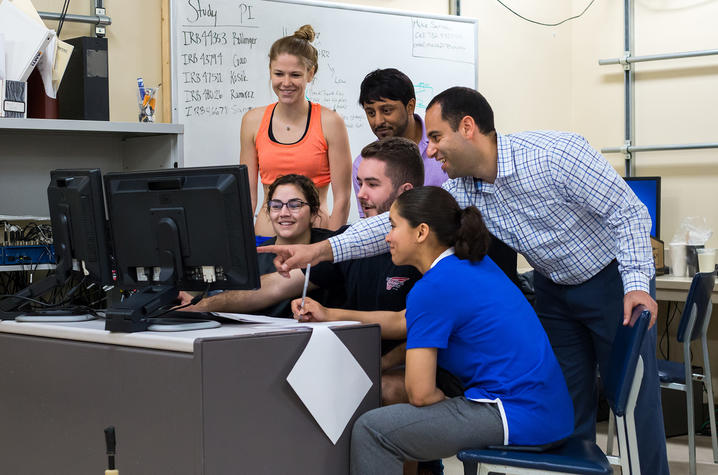UK Researcher’s Study Focuses on Painful Hip Condition

University of Kentucky researchers are in search of answers for those who suffer from a painful hip condition known as femoroacetabular impingement syndrome (FAIS). A study in the January issue of Clinical Biomechanics helps shed light on the short-term outcome of arthroscopic surgery for the condition.
“Although FAIS can be experienced at any age, it often impacts the young and athletic, bringing their active lifestyles to a halt,” said study author Michael Samaan, an assistant professor of biomechanics at the UK College of Education Department of Kinesiology and Health Promotion.
FAIS is characterized by extra bone growth around the hip joint. The abnormal growth creates friction, which can damage the joint and cause severe pain. Hip surgery typically corrects the problem and alleviates hip pain, but the surgery’s impact on gait mechanics and cartilage health have not been studied extensively. Samaan’s work contributes to evidence researchers and clinicians can use to develop rehabilitation protocols to help patients safely return to previous activity levels following surgery, while preserving hip joint cartilage health.
His most recent study, co-authored by colleagues at the University of California San Francisco, used gait analysis to analyze FAIS patients’ walking patterns. Researchers also took images of the FAIS patients' surgical hip joint using magnetic resonance imaging (MRI) to quantify the chemical composition of the hip joint cartilage. FAIS patients in the study underwent gait analysis and MRI before surgery and seven months after surgery. The FAIS patients' pre- and post- surgical data was compared to 10 matched asymptomatic healthy control participants.
“We found that hip joint kinematics during walking, or the position of the hip joint during walking, was not changed at seven months post surgery,” Samaan said. “However, there is a shift in the way the hip joint is loaded in the FAIS patients after surgery. FAIS patients who walked with higher hip joint loading after surgery exhibited better cartilage health.”
While studies have been conducted utilizing longer follow-up (more than seven months), Samaan’s is among the first to look at short-term outcomes of arthroscopic surgery. Researchers say this may be important in developing post-surgical rehabilitation protocols aimed at preventing the onset of hip joint degeneration, as this is the time period around when FAIS patients are cleared for full activity.
Samaan, who came to the university in 2018, joined faculty specializing in FAIS — including Dr. Stephen Duncan, an orthopedic surgeon who performs surgical intervention for the condition; radiologists Dr. Riham El-Khouli and Dr. Aaron Fain, who have expertise in assessing images of conditions such as FAIS; Brian Noehren, a physical therapist/biomechanist who conducts extensive work with patients who have undergone ACL reconstruction; Babak Bazrgari, an engineer with expertise in advanced biomechanical modeling; and researcher Cale Jacobs, who is examining the psychosocial aspects of FAIS — to gain a better understanding of how FAIS develops and the long-term impact on patients who have surgery for FAIS. They hope their work will lead to better treatments, or perhaps even prevention, in patients shown to be at-risk of bone and cartilage problems in the hip.
“Working as part of a multidisciplinary research team was a priority of mine,” Samaan said. “It is the best way of obtaining a comprehensive understanding of the effects of FAIS on hip joint bone and cartilage health and mechanics.”
Samaan, who was most recently a postdoctoral fellow at the University of California, San Francisco, was attracted to UK as he explored faculty positions across the country. As one of a handful of universities across the nation with a land-grant mission and a medical center and academic units on one contiguous campus, UK provides researchers the opportunity to more easily collaborate across specialty areas.
Samaan, who is trained as a mechanical and biomedical engineer, specializes in biomechanics, which involves applying mechanical principles to the human body. At UK, he has access to the Human Performance Laboratory, which consists of the Biodynamics and Biomotion Labs, as well as the Magnetic Resonance Imaging and Spectroscopy Center (MRISC) where extensive and sophisticated research is conducted, such as 3-D motion analysis and advanced musculoskeletal imaging.
Samaan’s research received a boost when he received a career-development award in early 2019 from the UK Center for Clinical and Translational Science’s KL2 program. It provides research training and mentorship to junior faculty in developing a clinical/translational research program. Ultimately, the goal of the program is to aid junior faculty in obtaining the skills needed to obtain large-scale federal research funding.
Serving as Samaan’s primary mentor for career development is Brian Noehren, an established researcher in the UK College of Health Sciences. He is a physical therapist holds a Ph.D. in biomechanics and movement science, and Samaan says their research aligns nicely.
As a faculty member in the Department of Kinesiology and Health Promotion, Samaan teaches courses that are helping undergraduates learn about biomechanics and graduate students study musculoskeletal modeling.
Whether as a teacher, researcher or scholar, Samaan makes it a priority to make connections with people. Behind the advanced technologies and interventions, he always keeps in mind the human lives that are impacted.
“Anyone who comes through my lab as a study participant, I always ask them what their story is,” Samaan said. “Conditions like FAIS take a toll on people physically, emotionally and mentally. We need to consider all the patient is going through. At the end of the day, you want people to be happy in their lives.”
Credits
Amanda Nelson (College of Education)

